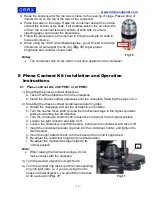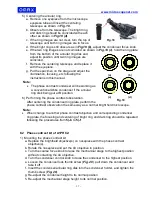
www.microscopenet.com
- 2 -
ii.
Care and Maintenance
1. Do not attempt to disassemble any component including eyepieces, objectives or
focusing assembly.
2. Keep the instrument clean; remove dirt and debris regularly. Accumulated dirt on
metal surfaces should be cleaned with a damp cloth. More persistent dirt should be
removed using a mild soap solution.
Do not use organic solvents for cleansing
.
3. The outer surface of the optics should be inspected and cleaned periodically using
an air stream from an air bulb. If dirt remains on the optical surface, use a soft cloth
or cotton swab dampened with a lens cleaning solution (available at camera stores).
All optical lenses should be swabbed using a circular motion. A small amount of
absorbent cotton wound on the end of a tapered stick makes a useful tool for
cleaning recessed optical surfaces. Avoid using an excessive amount of solvents as
this may cause problems with optical coatings or cemented optics or the flowing
solvent may pick up grease making cleaning more difficult. Oil immersion objectives
should be cleaned immediately after use by removing the oil with lens tissue or a
clean, soft cloth.
4. Observe the specimen with the 4X, 10X and 40X objectives in order, then observe
the specimen with the 100X objective. Apply the immersion oil on the slide cover
with the 100X objective. Do not let the immersion oil to contact with the dry
objectives lens (especially the 40X). Clean the dry objective lens using the camera
cleaning kit if the immersion oil is on the dry objectives lens. Clean the 100X
objective lens first using the camera cleaning kit after observing the specimen with
the 100X objective, then clean the specimen. More persistent dirt should be
removed using a little bit alcohol.
Do not use organic solvents for cleansing
.
5.
Store the instrument in a cool, dry environment. Cover the microscope with the dust
cover when not in use.

































